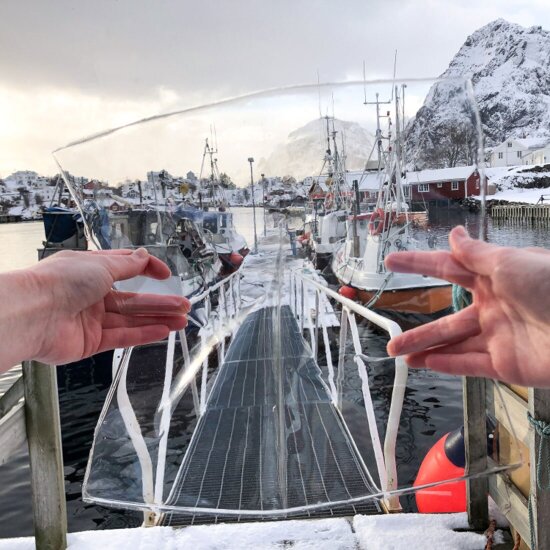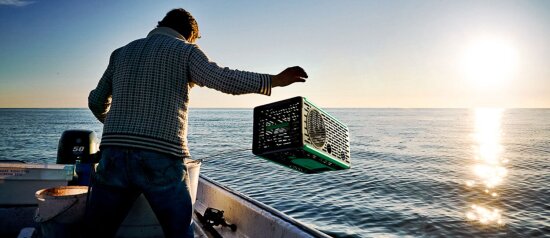We all agree that the products and services of tomorrow must be green and user-friendly. But to achieve them, we need new thinking, new knowledge and courage. This year’s winners of the DOGA Award Newcomer have these qualities in abundance.
This video shows how this year’s newcomers – students and newly established designers and architects – are helping with the green transition through their use of design and architecture.
“The newcomers are absolutely fascinating! The people who have been given this award are people we will keep our eye on and listen to – because they are the people who will shape our future,” says Tor Inge Hjemdal, CEO of DOGA.
For us, sustainability is about being informed. It is a privilege to create a product that helps users to make better and more informed choices.
Here are this year’s seven newcomer projects:
Beta kommune – Elias Olderbakk and Erlend Grimeland
In the Beta kommune Master’s thesis, the two young designers Elias Olderbakk and Erlend Grimeland show how design and digital technology can help to make the municipalities even better for everyone living and working in them.
By involving residents, they have created solutions that address people’s real, everyday needs. Now they hope that the municipalities of Norway will be inspired to take a fresh look at digitalisation.
“We hope that those in charge can understand that digitalisation is about more than improving efficiency, and that it can be about creating good places for residents to live,” the design duo say.

Photo: Elias Olderbakk og Erlend Grimeland
Sammensveiset – Aksel Borgen and Gustav Bjørngaard Rødde
In this Master’s thesis in architecture at NTNU, Aksel Borgen and Gustav Bjørngaard Rødde challenge the prevailing view of “mixed use development”, where the idea is to use a mix of functions to make it attractive to live, work and shop in the same neighbourhood.
But, according to Aksel Borgen and Gustav Bjørngaard Rødde, there is something that is rarely seen in mixed-use developments – and that is industry and manufacturing.
Basing their study on the Sluppen industrial zone in Trondheim – which is under pressure to be transformed into homes and businesses – they have been looking at how industry could become part of the area, instead of being moved out of the city.
SLOG – Marie Frogner
“SLOG is proof that we have to take another look at things, look at the resources we already have in Norway and at the value of a circular economy”, says Marie Frogner.
In her thesis at the Oslo School of Architecture and Design (AHO), she starts with the government strategy for leftover marine raw materials (2019) and looks into how fish offal – or to be more precise fish gelatine – could be an alternative to plastic.
Through a combination of system-oriented design, service design and product design, Marie has developed a material that looks like clear plastic and has many of the same properties. But, unlike plastic, it is one hundred per cent natural and edible. She proposes various potential uses, including as an alternative to boil–in–bag rice and similar products.

Photo: Marie Frogner
A future in ruins – Sindre Kartvedt
This project is architecture student Sindre Kartvedt’s thesis at the Bergen School of Architecture.
The thesis looks at the ruins of an old wave power station in Øygarden municipality near Bergen. Many people would like to see this old building demolished, but in his thesis, Sindre shows that the place has qualities that should be preserved and developed.
“It was important for me to preserve some of the mystique that people go there to experience, while creating something new that was in the spirit of this place,” says Sindre Kartvedt.
His proposals include building several new wave power stations and turning the area into an experience centre where people can learn about the wind, weather, sea and natural forces.
Being Buoyant – Gard Hagen and Jonas Carlsen
In the Being Buoyant Master’s thesis, design students Kolstad Carlsen and Gard Hagen have dived deep into the conditions and culture of pot fishing.
Fishing for crab and lobster using pots is popular but controversial, because far too many pots get
left at the bottom of the sea. This not only causes pollution, but also means that fish and shellfish are trapped and suffer a painful death.
The two students have designed a completely new type of pot that makes the fishing more humane and prevents pollution. For example, the pot is fitted with a time switch that opens the pot and releases the catch if it is not hauled up in time. After a while, it will also float up to the surface.
“For us, sustainability is about being informed. It is a privilege to create a product that helps users to make better and more informed choices,” say Jonas Kolstad Carlsen and Gard Hagen.

Photo: Gard Hagen
Linje – Åse Lilly Salamonsen and Sofie Finnøy Vestøl
Linje is a project that makes choosing subjects for further education easier and safer for lower secondary school pupils. Design students Sofie Finnøy Vestøl and Åse Lilly Salamonsen wanted to design the service on the young people’s terms, and have worked closely with pupils in their development work.
“During the project, our work has been varied, involving conversations with young people, continuously user-testing the content of the service and the way we convey information, and how user-friendly it is,” says Finnøy Vestøl.
The service has now been purchased by utdanning.no. This means that LINJE will become a reality, and could help pupils all over the country make choices about their education. The young designers have succeeded in meeting what is a real and major need for pupils, schools and society.
Slidedrain – Henning Patrickson and Stian Bongard
Every year, water leaks due to incorrectly installed drains cause almost NOK 320 million worth of damage. This could be avoided if the drains on the market did not require so much individual customisation – with the risk of human error that this entails.
Norwegian University of Science and Technology (NTNU) students Henning Patrickson and Stian Bongard have worked with tradesmen and the heating, water and sanitation industry to develop a new type of drain for wet rooms. The drain, which they have called Slidedrain, will be manufactured from recycled ropes and nets from the fishing industry.
“Our vision is to reduce the frequency of water damage due to incorrectly installed drains. We also want to penetrate a fairly challenging market dominated by major players with a Norwegian product made from recycled plastics, which we think is better than anything currently on the market,” says Henning Patrickson.